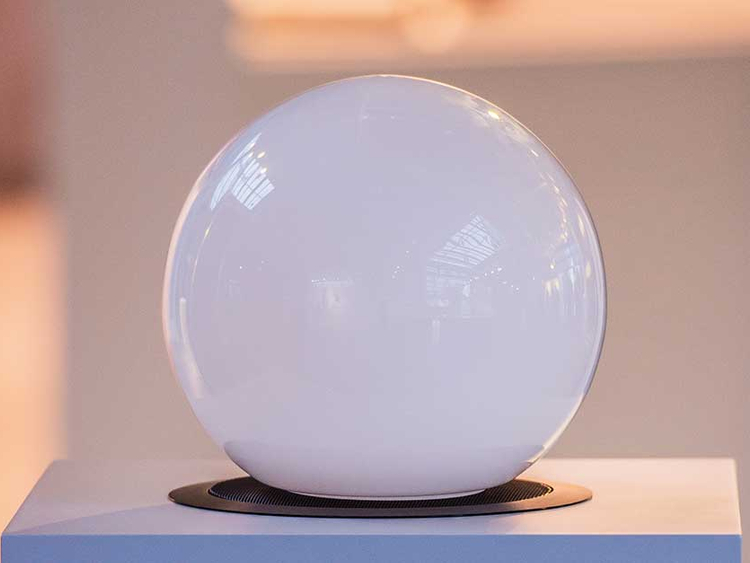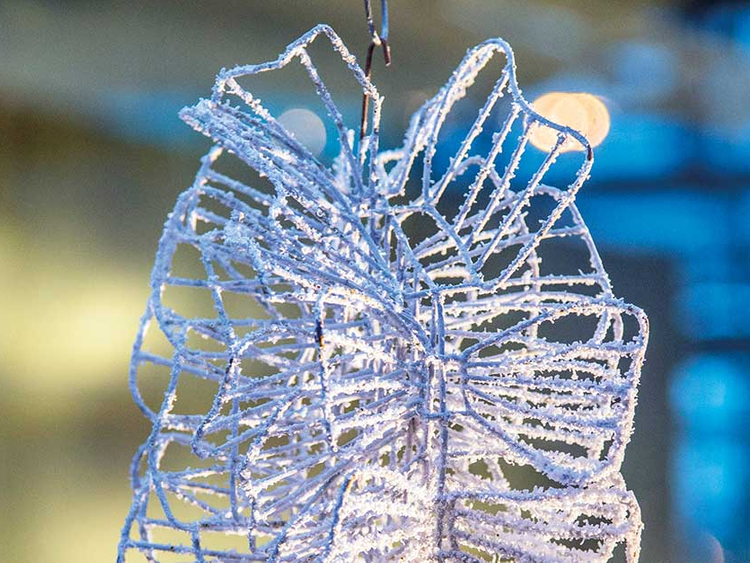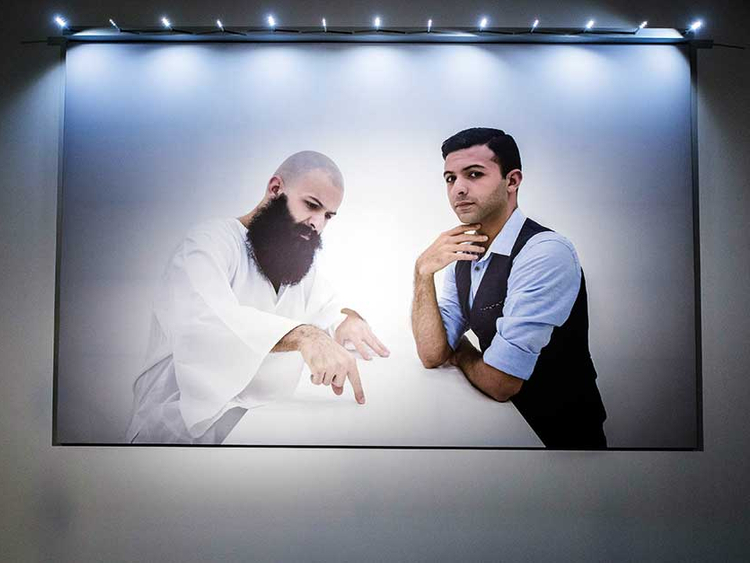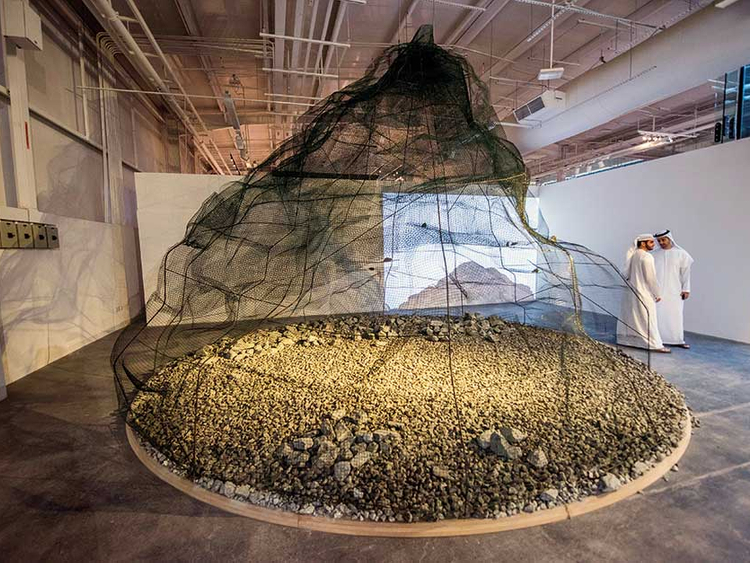
Eight emerging artists - Asma Al Ahmed, Hatem Hatem, Manal Al Dowayan, Maytha Al Shamsi, Nasser Alzayani, Saif Mhaisen, Sara Al Haddad, Talal Al Ansari and Talin Hazbar - express their specific viewpoints in an aggregate that illustrates the changing landscape of UAE through its art in the capital’s Warehouse421.
To put the event’s concept in the right perspective, the opening lines in its brochure quotes French cultural theorist, Jean Baudrillard’s statement that says, “Today abstraction is no longer that of the map, the double, the mirror, or the concept. Stimulation is no longer that of a territory, a referential being or substance, it is the generation by models of a real without origin or reality: A hyperreal. The territory no longer precedes the map, nor does it survive it. It is nevertheless the map that precedes the territory – precession of simulacra – that endangers the territory.” This is a quote from his book Simulacra and Simulation, which speaks in depth about a theory of contemporary culture that relies on displacing economic notions of cultural production with notions of cultural expenditure. This book represents an effort to rethink cultural theory from the perspective of a concept of cultural materialism.
“As the exteriors began to shift, so did the mindsets, the language, traditions and identities that were once labeled so clearly,” says Munira Al Sayegh, Bayn’s Curator, in her curatorial statement.
Nameless Guardians
At the venue you cannot miss looking up at this mysterious curtains of golden leaves hanging from the ceiling. Read up the inscription next to it and it is more than what meets the aesthetic eye. Titled The Tree of Guardians, this sculptural installation is by Saudi Arabian artist Manal Al Dowayan. Made of brass leaves, ink and fish wire, these golden leaves are suspended from the ceiling. They are beautiful to look at and unbelievable when you learn the story beneath. By highlighting the act of preservation, this installation underscores the constant state of disappearance due to change.
The leaves inscribed with names of women from Saudi Arabia, are a set of family trees drawn on to paper that asses the unnatural state of disappearance in the documentation, or remembrance of the older generation of women to exist in Saudi Arabia. This work responds to the patriarchal society that documents the importance of male figure by constant remembrance of his name through the act of mentioning your father, grandfather and great grandfather’s name after saying your own and before ending it with your family name.
What Lies Beneath
Bayn: The In-Between seeks to describe, question, and expand on the threshold found between a starting point and its end. Throughout this exhibition, the state of in-between is highlighted as equally important to both the definitive beginning (the history of the United Arab Emirates) and its end goal (the future). The artists work in a wide variety of mediums, drawing on their surroundings, experiences and recollections. The exhibition is UAE Unlimited’s third exhibition and explores the transformation of the UAE through the artworks of eight conceptual artists. The show explores the transformations that the current generation of artists witnessed in the UAE, as well as the region. It’s curator Munira Al Sayegh, has worked with eight commissioned artists and a ninth internationally established guest artist from Saudi Arabia, Manal Al Dowayan, to create conceptual artworks in a wide variety of mediums.
Curator’s Perspective
“As the exteriors began to shift, so did the mindsets, the language, traditions and identities that were once labeled so clearly,” says Al Sayegh, who is also curator and programme officer at the Guggenheim Abu Dhabi. In her essay for the Bayn’s catalogue, Al Sayegh mentions the word ‘liminal’ to expand on what she means by the in-between. “Liminality derives from the 17th-century Latin word limen, meaning threshold.” This exhibition “seeks to describe, question and expand on the threshold found between a starting point and its end.”
The essay also details the curator’s experience of growing up in Abu Dhabi where she has herself witnessed the ‘drastic physical changes’ all around her. “The roads of the Corniche were extended by burying the sea, twice. These physical transformations were accounted for by the increase in the foreign and local population, which continued to dilute the culture that existed. My schooling took place at the American Community School of Abu Dhabi, where I was one of a handful Emiratis, and this was when my interest in the described state of in-between began,” writes Al Sayegh.
“I would search for guidance from my parents when plagued by uncertainty. This led me to realise the drastic difference between their time and their understanding of their surroundings, from the reality it has become. Ultimately I had created a niche culture that extended itself to being relevant when in the context of my American peers and when in the context of my Emirati family. Soon after, I began to notice that my native language, Arabic, was starting to weaken, with English dominating the majority of my spoken conversation in and out of school. One day a group of my cousins and I were speaking English with each other in my late grandfather’s house. After a while, my grandfather asked me to meet him privately. He asked me a hypothetical question. ‘When you dream, what language do you dream in?’ Just as the landscapes were transforming due to external impact, I realised I was too. A series of influences began to shape me, and I began to study what it was that got me to the point of existing in a state of in-between. This personal fascination is one that I shared with the artists, who in turn responded to and extended their own understanding of the concept of the in-between throughout the exhibition,” adds Al Sayegh.
Al Sayegh described how she and her peers (participating artists) felt suspended between the past and the future and proposed that this suspension be looked at in itself as a state, a generation, a part of the UAE’s history in the making,” mentions Maya Allison, chief curator and Galleries Director, NYU Abu Dhabi. Allison is also the curatorial advisor to Bayn.
Mountains of memory
Artist Asma Al Ahmed’s installation called Geo Displacement is a recreated construction site with wire mesh and projector. It studies the disappearance of the mountainscapes in the northern and eastern parts of the Emirates and their reappearance in construction materials used for building skyscrapers in the country and region. Ahmed’s work question’s the relationship point in which a reality becomes a distant memory.
While Asma’s work deals with commonplace construction material, Hatem Hatem’s Calcified Landscape uses marine calcified rock to simultaneously reflect a traditional building method in the UAE (using coral rock) and investigating the use of this method as a future regional building technique. Iraqi artist Hatem has exposed his art in a very scientific manner. The artwork has come to life after studying the decline of coral reefs around the world, particularly in the Gulf region, he elaborates the idea and beauty of ‘manufactured synthetic coral reefs’, used by conservationists. In the venue he installed water tanks and used electrical fields as salt magnets to attract artificial limestone formations in order to create transient sea habitats. Throughout the exhibition, the landscapes will be in a constant state of evolution. Visually, these exhibits are highly appealing, each resembling giant pendants in glass display cubes, like in a souq.
Self Portrait
If I could pick a personal favourite from the works on display here then it would be that of Saif Mhaisen’s. His autobiographical larger-than-life sized self portrait addresses delusion of time and place through a negotiation of self-alienation.
Self Portraits 11 & 12 is a large-scale photographic print that foregrounds internal debates of the self, and self duality. The performative photograph highlights a link between questions of truth and falsehood, affirmative and negative, old and new, internal and external, nature and pretence. The work visualises ideas of contrast, tension, and extreme difference. The image shows Mhaisen at different stages of his life, a year and six months apart, beginning in 2015 and ending in 2016. It shows his transformation from one character to the other within a clinical white space. The context, or lack there of, denies time and place.
On the left is a stern, firm man, with a large beard and a completely shaved head, in a white robe that claims time and a place. His hand gestures are certain, pointing at a definitive thought on the table. Although bound through the white background, the table is the only physical object separating the two characters from one another. On the other side of the table, a clean-shaven man is depicted in modern, colonialist clothing, representing a shift time and place, with hair neatly parted and combed to the side, and a body language that alludes to that of a listener. It is not immediately clear that the two portrayals are the same man – the transformation seen introduces a completely new being.
Betrol
Only few pieces are actually hanging on a wall here. One such is Talal Ansari’s digital print on wood - an illustrative piece based on the evolution of the UAE since the discovery of oil. The piece, called Masan’a Alrijal, is inspired by a quote from late Sheikh Zayed Bin Sultan Al Nahyan, the founding President of the UAE, when he responded to a question where he was asked about what the future of factories will be in the UAE. The drawing is a response that reveals the industrial post-oil revolution that the country underwent. Among the few inscriptions on the board one can read petrol, spelled out as ‘betrol’, hinting local phonetics. The illustration also studies elements, which introduces transformation that cam lead to moments of in-between.
I Am Hear
Sound installations also plays an important part in the exhibition. Maytha Al Shamsi created a 10-minute sound piece titled I Am Hear. It is a loop of natural and electronic sounds that consist of echoes and sonic nuances commonly heard in Abu Dhabi. Sounds such as car horns, the movement of water in the sea, animals and the various languages that populate the country comprise the recorded sounds in this work. By illustrating an evolving language, the piece aims to show the constant sense of change and transformation that exists in the country. Bayn Jissrain (Between Two Bridges) introduces a series of sounds inspired by the two main bridges in Abu Dhabi that connect the island to the mainland, connecting the first bridge to be built in Abu Dhabi in 1967, Maqta Bridge, and its Zaha Hadid designed contemporary counterpart, the Sheikh Zayed Bridge.
i am sorry
The state of in-between caused by return journey home instigates many more questions such as ‘what is home’ and where is home’. This is the underlining thought of Sara Al Haddad’s works here. She is one of the five Emirati artists who will represent the UAE at the Venice Biennale this year and has exhibited personal belongings here at Bayn. The most visually curious, of the five works she exhibits here, is the one made of sheets of tissue paper knitted together and placed on the ground. She also presents a cast of a cardboard box she used while moving house, that contains memorabilia from a cup cake wrapper to random objects with ballpoint etchings on them.
A shallow concrete box titled i am sorry, sits with a deconstructed book on top titled i am overwhelming. The sculptural work i am sorry is empty from the inside although, due to its external concrete facade, it alludes to a heavy presence. The imperfect box was cast from a box while Al Haddad used while moving her items from Baltimore, where she looks at the evolution of something that is otherwise solid, and reassesses its rigid existence by comparing its use over time and place. Symbolically, this box describes the return journey home – a new self going back to older settings and what that means in relation to transformation (progression versus regression). The box acts as a foundation, a base, which allows for support in both an emotional and a physical sense. The hollow feature of the box gives room for growth in order to create something that is malleable. The concrete structure is a safe space to ask questions, and reflect upon the, to understand change, evolution. And the becoming of someone new.
Shifting Borders
Bayn: the In-Between is a collaboration between UAE Unlimited and a number of UAE-based artists, curators, and institutions, highlighting the collective nature of the creative community in the UAE today. Hosted at Warehouse421 in Abu Dhabi, the exhibition is being developed with the support of Maraya Productions in Sharjah. Maya Allison, Founding Director of NYU Abu Dhabi Art Gallery, is the Senior Curatorial Adviser to the project and mentoring the exhibition’s curator Munira Al Sayegh.
Everyone behind the scenes support witnessing the change. They unanimously agree on the importance of exploring the artists’ perspective to this change. “The Middle East has witnessed “transformation” in multiple ways and on multiple levels. From shifting borders to political upheaval. From the removal of the old and the arrival of the new. From youth to maturity. From fragility to durability. These transformations have affected all aspects of life, from growth in agriculture, to education, health, housing and industry. For a young nation that recently celebrated its 45th Anniversary, it’s even more true here in the UAE. We’ve witnessed spectacular growth unparalleled in the region. We are most grateful for all the enthusiastic, generous and wonderful support we have received from the entire team at Warehouse421. We deeply admire and respect the significant ongoing contribution made by Warehouse421 to the development of the arts and cultural landscape throughout the nation,” said Shobha Pia Shamdsani, Executive Director of UAE Unlimited.
A New Wave
UAE Unlimited, a young satellite platform founded and supported by His Highness Sheikh Zayed bin Sultan Bin Khalifa Al Nahyan, who is also one of the youngest prominent patrons of arts in the country. It’s mission is to nurture and develop emerging creative practitioners in the UAE.
“Our platform’s third iteration comes at a time when we are all examining our identities in light of the rapid shifts we are witnessing around us. I am proud to be part of the Bayn generation, the generation that took on the responsibility of moving the narrative forward towards a more nuanced understanding of the contexts of home and belonging, bringing together the best practices in art, culture, and development to the localities we belong to. UAE Unlimited is proud to support and work alongside such great emerging talent in understanding what it truly means to actively be a part of this change. The artworks exhibited at Bayn and the curatorial thought process behind it highlight an urgent need for us to pause, and rethink our fixed notions of identity and invite us to redefine what it means to be part of this new wave of thinkers who are constantly moving forward,” said His Highness Sheikh Zayed Bin Sultan Bin Khalifa Al Nahyan, Patron of UAE Unlimited
Archana R.D. aka B’lu is an artist-journalist based in the UAE who writes on global art and culture.
Bayn: The In-Between is on show at Abu Dhabi’s Warehouse421 until June 18.















